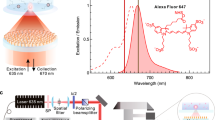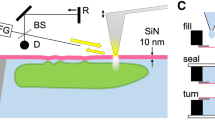Abstract
Although single-molecule fluorescence spectroscopy was first demonstrated at near-absolute zero temperatures (1.8 K)1, the field has since advanced to include room-temperature observations2, largely owing to the use of objective lenses with high numerical aperture, brighter fluorophores and more sensitive detectors. This has opened the door for many chemical and biological systems to be studied at native temperatures at the single-molecule level both in vitro3,4 and in vivo5,6. However, it is difficult to study systems and phenomena at temperatures above 37 °C, because the index-matching fluids used with high-numerical-aperture objective lenses can conduct heat from the sample to the lens, and sustained exposure to high temperatures can cause the lens to fail. Here, we report that TiO2 colloids with diameters of 2 µm and a high refractive index can act as lenses that are capable of single-molecule imaging at 70 °C when placed in immediate proximity to an emitting molecule. The optical system is completed by a low-numerical-aperture optic that can have a long working distance and an air interface, which allows the sample to be independently heated. Colloidal lenses were used for parallel imaging of surface-immobilized single fluorophores and for real-time single-molecule measurements of mesophilic and thermophilic enzymes at 70 °C. Fluorophores in close proximity to TiO2 also showed a 40% increase in photostability due to a reduction of the excited-state lifetime.
This is a preview of subscription content, access via your institution
Access options
Subscribe to this journal
Receive 12 print issues and online access
$259.00 per year
only $21.58 per issue
Buy this article
- Purchase on Springer Link
- Instant access to full article PDF
Prices may be subject to local taxes which are calculated during checkout




Similar content being viewed by others
References
Orrit, M. & Bernard, J. Single pentacene molecules detected by fluorescence excitation in a p-terphenyl crystal. Phys. Rev. Lett. 65, 2716–2719 (1990).
Betzig, E. & Chichester, R. J. Single molecules observed by near-field scanning optical microscopy. Science 262, 1422–1425 (1993).
Ambrose, W. P. et al. Single molecule fluorescence spectroscopy at ambient temperature. Chem. Rev. 99, 2929–2956 (1999).
Weiss, S. Fluorescence spectroscopy of single biomolecules. Science 283, 1676–1683 (1999).
Yu, J., Xiao, J., Ren, X., Lao, K. & Xie, X. S. Probing gene expression in live cells, one protein molecule at a time. Science 311, 1600–1603 (2006).
Sako, Y., Minoghchi, S. & Yanagida, T. Single-molecule imaging of EGFR signalling on the surface of living cells. Nature Cell. Biol. 2, 168–172 (2000).
Koyama, K., Yoshita, M., Baba, M., Suemoto, T. & Akiyama, H. High collection efficiency in fluorescence microscopy with a solid immersion lens. Appl. Phys. Lett. 75, 1667–1669 (1999).
Brody, J. P. & Quake, S. R. A self-assembled microlensing rotational probe. Appl. Phys. Lett. 74, 144–146 (1999).
Helseth, L. E. & Fischer, T. M. Cooperative microlenses. Opt. Express 12, 3428–3435 (2004).
Helseth, L. E., Wen, H. Z. & Fischer, T. M. Colloidal optomagnetic dimmer. Langmuir 22, 3941–3944 (2006).
Domachuk, P. et al. Application of optical trapping to beam manipulation in optofluidics. Opt. Express 13, 7265–7275 (2005).
Wu, M. H. & Whitesides, G. M. Fabrication of arrays of two-dimensional micropatterns using microspheres as lenses for projection photolithography. Appl. Phys. Lett. 78, 2273–2275 (2001).
Denk, R., Piglmayer, K. & Bäuerle, D. Laser-induced etching and deposition of W using a-SiO2 microspheres. Appl. Phys. A: Mater. 76, 549–550 (2003).
McLeod, E. & Arnold, C. B. Subwavelength direct-write nanopatterning using optically trapped microspheres. Nature Nanotech. 3, 413–417 (2008).
Tatarkova, S. A., Carruthers, A. E. & Dholakia, K. One-dimensional optically bound arrays of microscopic particles. Phys. Rev. Lett. 89, 283901 (2002).
Wenger, J., Gerard, D., Aouani, H. & Rigneault, H. Disposable microscope objective lenses for fluorescence correlation spectroscopy using latex microspheres. Anal. Chem. 80, 6800–6804 (2008).
Kneipp, J. et al. Gold nanolenses generated by laser ablation-efficient enhancing structure for surface enhanced Raman scattering analytics and sensing. Anal. Chem. 80, 4247–4251 (2008).
Barnes, M. D., Ng, K. C., Whitten, W. B. & Ramsey, J. M. Detection of single Rhodamine 6G molecules in levitated microdroplets. Anal. Chem. 65, 2360–2365 (1993).
Brooks Shera, E., Seitzinger, N. K., Davis, L. M., Keller, R. A. & Soper, S. A. Detection of single fluorescent molecules. Chem. Phys. Lett. 174, 553–557 (1990).
Furuike, S. et al. Temperature dependence of the rotation and hydrolysis activities of F1-ATPase. Biophys. J. 95, 761–770 (2008).
Farjadpour, A. et al. Improving accuracy by subpixel smoothing in the finite-difference time-domain. Opt. Lett. 31, 2972–2974 (2006).
Whitmore, P. M., Alivisatos, A. P. & Harris, C. B. Distance dependence of electronic energy transfer to semiconductor surfaces: 3nπ* pyrazine/GaAs(110). Phys. Rev. Lett. 50, 1092–1094 (1983).
Sluch, M. I., Vitukhnovsky, A. G. & Petty, M. C. Anomalous distance dependence of fluorescence lifetime quenched by a semiconductor. Phys. Lett. A 200, 61–64 (1995).
Campion, A., Gallo, A. R., Harris, C. B., Robota, H. J. & Whitmore, P. M. Electronic energy transfer to metal surfaces: a test of classical image dipole theory at short distances. Chem. Phys. Lett. 73, 447–450 (1980).
Crackel, R. L. & Struve, W. S. Non-radiative excitation decay of cresyl violet on TiO2: variation with dye–surface separation. Chem. Phys. Lett. 120, 473–476 (1985).
Farahani, J. N., Pohl, D. W., Eisler, H. J. & Hecht, B. Single quantum dot coupled to a scanning optical antenna: a tunable superemitter. Phys. Rev. Lett. 95, 017402 (2005).
Jin, S. & Lian, T. Electron transfer dynamics from single CdSe/ZnS quantum dots to TiO2 nanoparticles. Nano Lett. 9, 2448–2454 (2009).
Robel, I., Kuno, M. & Kamat, P. V. Size-dependent electron injection from Excited CdSe quantum dots into TiO2 nanoparticles. J. Am. Chem. Soc. 129, 4136–4137 (2007).
Chen, C., Qi, X. & Zhou, B. Photosensitization of colloidal TiO2 with a cyanine dye. J. Photochem. Photobiol. A 109, 155–158 (1997).
Schwartz, J. J. & Quake, S. R. Single molecule measurement of the ‘speed limit’ of DNA polymerase. Proc. Natl Acad. Sci. USA 106, 20294–20299 (2009).
Schwartz, J. J. & Quake, S. R. High density single molecule surface patterning with colloidal epitaxy. Appl. Phys. Lett. 91, 083902 (2007).
Acknowledgements
The authors thank M. Brongersma, H.J. Lee and M.F. Yanik for discussions, and E. Townsend for writing the instrumentation software. This work was supported in part by the Department of Defense Advanced Research Projects Agency Optofluidics Center, the National Human Genome Research Institute (5R01HG003594-04), and the Howard Hughes Medical Institute. S.S. was funded by a Marie Curie fellowship (MOIF-CT-2006-0400320 FRETANDFORCE).
Author information
Authors and Affiliations
Contributions
J.J.S., S.S. and S.R.Q. conceived and designed the experiments. J.J.S. and S.S. performed the experiments. J.J.S. and S.S. analysed the data. J.J.S., S.S. and S.R.Q. wrote the paper.
Corresponding author
Ethics declarations
Competing interests
We have filed a patent on colloidal lenses.
Supplementary information
Supplementary information
Supplementary information (PDF 1131 kb)
Rights and permissions
About this article
Cite this article
Schwartz, J., Stavrakis, S. & Quake, S. Colloidal lenses allow high-temperature single-molecule imaging and improve fluorophore photostability. Nature Nanotech 5, 127–132 (2010). https://doi.org/10.1038/nnano.2009.452
Received:
Accepted:
Published:
Issue Date:
DOI: https://doi.org/10.1038/nnano.2009.452
This article is cited by
-
Strain-tunable optical microlens arrays with deformable wrinkles for spatially coordinated image projection on a security substrate
Microsystems & Nanoengineering (2022)
-
Fabrication of Waterproof Artificial Compound Eyes with Variable Field of View Based on the Bioinspiration from Natural Hierarchical Micro–Nanostructures
Nano-Micro Letters (2020)
-
Broadband highly directive 3D nanophotonic lenses
Nature Communications (2018)
-
Manipulation and detection of single nanoparticles and biomolecules by a photonic nanojet
Light: Science & Applications (2016)
-
Enhanced light collection in fluorescence microscopy using self-assembled micro-reflectors
Scientific Reports (2015)



